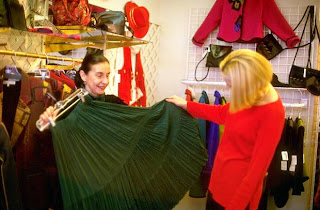What is a gift receipt? In general, a receipt is a piece of paper from a store that shows 1) when something was bought, 2) what price was paid for the item, and 3) from which store the item was purchased. A gift receipt contains all this information too, except the price of the item is coded. Why is the price coded? We consider it impolite to let a person know how much was paid for the present, so gift receipts are coded to hide the price.
So, if a person is unhappy with a present he’s gotten, he has two options: 1) He can exchange the present for something more to his liking, or 2) he can get a refund.
1) Exchange
Sometimes, the person likes the present, except it is the wrong size, wrong color, etc. He can take the item and the gift receipt back to the store. Then he can pick out a present that is the right size, right color, etc. This situation is easier for the clerk, since there is generally no difference in price between the original present and the exchange. Usually, the clerk will scan the information from the receipt. Then the clerk will scan the information from the exchange. This is so the store’s inventory will remain accurate and up-to-date. The clerk will probably make a note of the exchange on the receipt.

Sometimes, the person will want to exchange the old present for another item that is completely different. For example, maybe a person got a sweater as a gift, but they want to have a pair of shoes instead. In this case, the clerk usually treats this as two separate transactions: one return, and one purchase. The clerk scans the gift receipt for the original purchase information. The person returning the present will get a store credit equal to the amount paid for the original purchase. This credit is then applied to the purchase of the new item. If the cost of the new item is less than the cost of the original present, the person will get a refund for the difference, or get a store credit. If the cost of the new item is greater than the cost of the original present, the person will have to pay the difference.
Both cases are good from the store’s perspective, because the sale is saved, and the customer is happy. It is a “win-win” situation: both sides benefit from the deal.
2) Refund
Sometimes, the person likes nothing about the present. He would rather have the money instead of the present. In this case, he can be refunded the price of the gift. The clerk will scan the information about the original purchase and determine how much money the person will get back. From the store’s perspective, this is not a good thing, because it is the same as a lost sale. But the store will do it anyhow, because it is good for customer relations: “The customer is always right.”



No comments:
Post a Comment